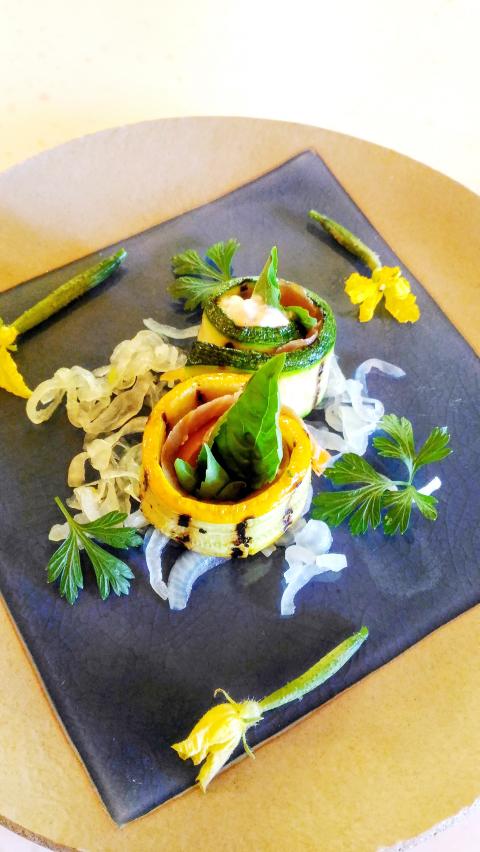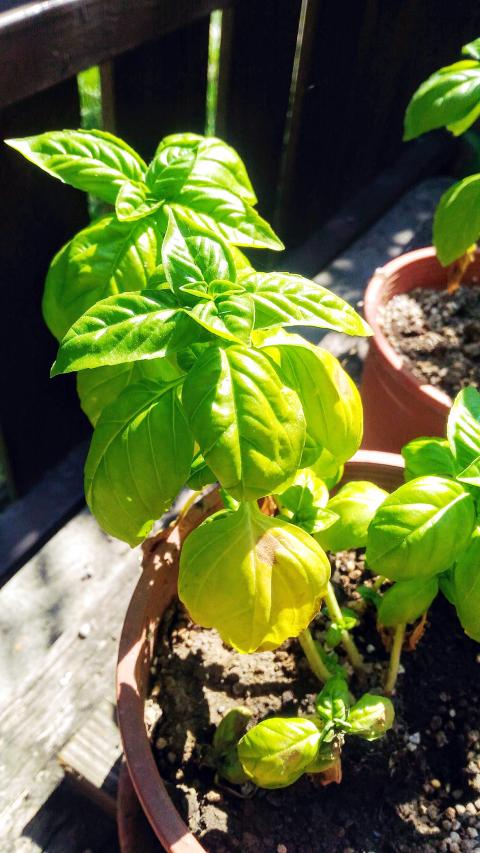Basil is one of the most aromatic of herbs, easily recognized, but often confusing in its variety of appearance and flavor. There are hundreds of types, the most immediately recognized being sweet basil, also called Genovese basil, the key ingredient in so many classic Italian dishes, and Thai basil, unsurprisingly a staple of Thai cuisine. The variety most sold in Taiwan under the generic name jiucengta (九層塔) is closer to Thai basil than it is to sweet, but there seems to be little consensus as to whether it is, strictly speaking, Thai basil or a variety of its own.
The name basil covers a wide territory of taste and aroma, and there is a large quantity of discussion of local food and recipe sites regarding questions like whether local basil can be used for pesto. It is basil after all. The short answer to that question is: No. Indeed my first introduction to local basil was just such an attempt, and while the result was not entirely inedible, the sharp, almost acrid flavor and pungent spiciness required considerable strength of character to ingest, and no amount of pine nuts and parmigiana was going to bring sweetness to the dish.
This is not to say that local jiucengta is an inferior type of basil, it is simply a different one, suitable to other preparations. It is perfect for the pungent Taiwanese eatery staple, three-cup chicken (三杯雞), and there is nothing better to provide a bit of zing to deep fried chicken pieces (鹽酥雞) and other tidbits at your local night market. It is also perfectly suited to sharpening the taste of most Thai dishes or sprinkled on top of Vietnamese pho. For Taiwan’s humid climate, it is the default basil, able to grow and produce abundant harvests of leaves even with minimal supervision. But leave it out of your bruschetta.

Photo: Ian Bartholomew
While sweet basil does not do so well in Taiwan, it is still relatively easy to grow, and offers a more delicate flavor that is perfect for salads and lightly seasoned dishes. It does not keep well, and the leaves will quickly oxidize once chopped. But washed and thoroughly dried, whole leaves can be kept for a couple of days in the fridge in an airtight container. Dried basil yields an insipid flavor, losing much of its pungency and vitality, but this has not prevented its sale as a dried herb — this may have some uses, but should not be mistaken as a suitable substitute for the fresh leaf. If you enjoy using sweet basil, it is best to grow it yourself. There are also a few methods of preserving its delicious flavor. Preservation in oil is the most common, but a much better method is to layer the leaves with salt. Neither method actually preserves the basil leaf, but keeps its flavor alive for use as an excellent flavoring for all kinds of dishes.
But nothing beats fresh sweet basil leaves, and even a whiff of its deeply complex perfume is enough to explain why it is sometimes referred to as the “king of herbs.” And more than simply tasting fantastic, it is also said to have anti-bacterial properties that actually makes the food you eat safer. It is particularly recommended as an addition to uncooked foods such as salads, as its essential oils have been show to retard the growth of various strains of bacteria that may cause intestinal discomfort when ingested. It is also a powerful anti-inflammatory, antioxidant and is recognized as having significant benefits for cardiovascular health. What more can you ask of something you put in your salad or pasta?
Ian Bartholomew runs Ian’s Table, a small guesthouse in Hualien. He has lived in Taiwan for many years writing about the food scene and has decided that until you look at farming, you know nothing about the food you eat. He can be contacted at Hualien202@gmail.com.

Photo: Ian Bartholomew
Smoked salmon rolls
Recipe
(serves two)
Fresh basil leaves provide a delicious punch to this simple dish. Having a couple of plants within easy reach of the kitchen counter is a great way to ensure that you always have some lovely leaves to toss into whatever you are cooking. The yogurt used in this dish is strained to provide greater thickness and a more intense flavor. If you make your own yogurt, this is easily done by placing the yogurt on some muslin in a strainer and leave it for three or four hours, resulting in an almost cream cheese-like consistency. This may not work with commercial yogurt as some brands seem to contain ingredients that prevent the separation of the whey from the curds.
Ingredients
200g smoked salmon
20 fresh basil leaves
1 zucchini
1 yellow squash
half an onion
100 ml yogurt, strained
zest and juice of half a lemon
four stems flat leaf parsley
salt and pepper
olive oil
Directions
1. Slice the zucchini and yellow squash lengthwise into slices about 0.5cm thick. Season generously with salt and pepper and brush with olive oil.
2. Heat a griddle and cook the zucchini and yellow squash for about two minutes a side, or until you get nice charred stripes. You might have to do this in two or three batches. Set aside and allow to cool.
3. Thinly slice the onion and sprinkle with salt. Set aside for about 20 minutes, until the onions start to release water. Squeeze the onions to press out as much liquid as possible.
4. Mix lemon zest and a splash of lemon juice to the yogurt. Season with salt and pepper.
5. Lay the slices of zucchini and yellow squash out on a tray. Place one long strip of salmon on it, then a dollop of yogurt and a couple of basil leaves. Roll it up. Avoid the temptation to overfill the rolls with salmon, as the flavor is best when the smoked salmon doesn’t dominate.
6. Mix the onions and flat leaf parsley and serve together with the salmon rolls.
Ian Bartholomew runs Ian’s Table, a small guesthouse in Hualien. He has lived in Taiwan for many years writing about the food scene and has decided that until you look at farming, you know nothing about the food you eat. He can be contacted at Hualien202@gmail.com.

Following the shock complete failure of all the recall votes against Chinese Nationalist Party (KMT) lawmakers on July 26, pan-blue supporters and the Chinese Communist Party (CCP) were giddy with victory. A notable exception was KMT Chairman Eric Chu (朱立倫), who knew better. At a press conference on July 29, he bowed deeply in gratitude to the voters and said the recalls were “not about which party won or lost, but were a great victory for the Taiwanese voters.” The entire recall process was a disaster for both the KMT and the Democratic Progressive Party (DPP). The only bright spot for

Water management is one of the most powerful forces shaping modern Taiwan’s landscapes and politics. Many of Taiwan’s township and county boundaries are defined by watersheds. The current course of the mighty Jhuoshuei River (濁水溪) was largely established by Japanese embankment building during the 1918-1923 period. Taoyuan is dotted with ponds constructed by settlers from China during the Qing period. Countless local civic actions have been driven by opposition to water projects. Last week something like 2,600mm of rain fell on southern Taiwan in seven days, peaking at over 2,800mm in Duona (多納) in Kaohsiung’s Maolin District (茂林), according to

Aug. 11 to Aug. 17 Those who never heard of architect Hsiu Tse-lan (修澤蘭) must have seen her work — on the reverse of the NT$100 bill is the Yangmingshan Zhongshan Hall (陽明山中山樓). Then-president Chiang Kai-shek (蔣介石) reportedly hand-picked her for the job and gave her just 13 months to complete it in time for the centennial of Republic of China founder Sun Yat-sen’s birth on Nov. 12, 1966. Another landmark project is Garden City (花園新城) in New Taipei City’s Sindian District (新店) — Taiwan’s first mountainside planned community, which Hsiu initiated in 1968. She was involved in every stage, from selecting

As last month dawned, the Democratic Progressive Party (DPP) was in a good position. The recall campaigns had strong momentum, polling showed many Chinese Nationalist Party (KMT) lawmakers at risk of recall and even the KMT was bracing for losing seats while facing a tsunami of voter fraud investigations. Polling pointed to some of the recalls being a lock for victory. Though in most districts the majority was against recalling their lawmaker, among voters “definitely” planning to vote, there were double-digit margins in favor of recall in at least five districts, with three districts near or above 20 percent in